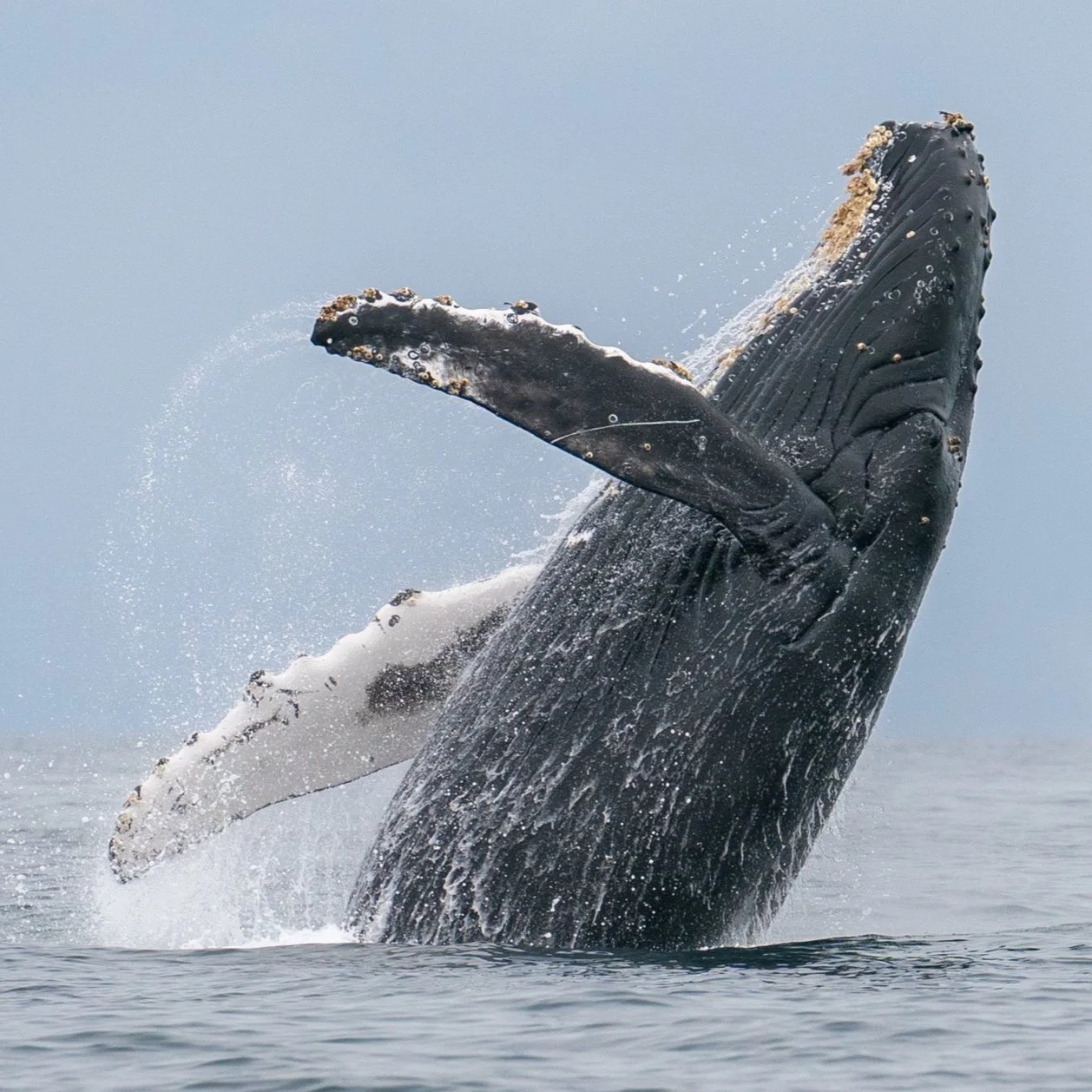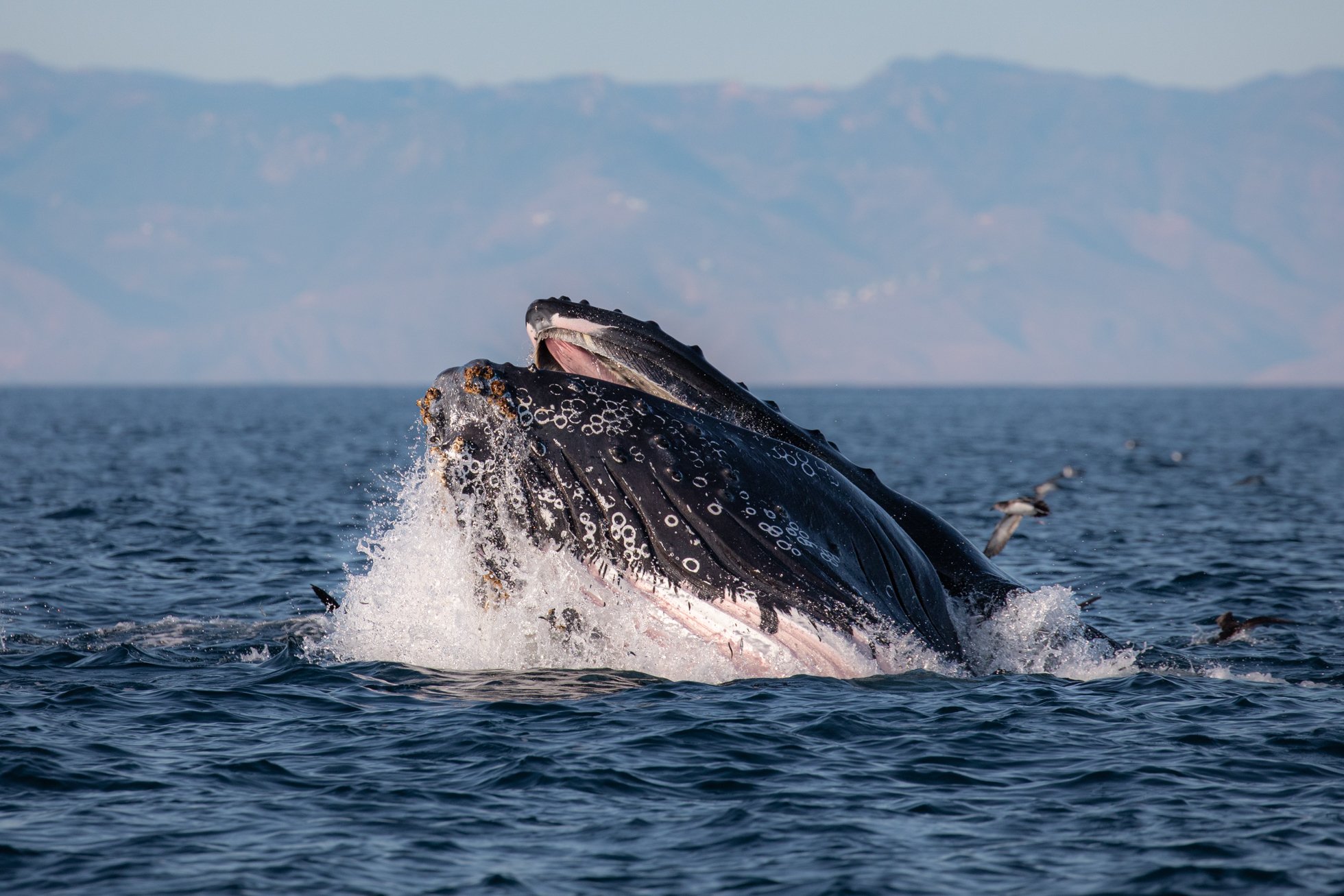
Humpback Whale
Humpback Whale Behavior
How to identify individual humpback whales
For scientific purposes we are able to use unique markings on whales and dolphins to non-invasively track them across geographic areas and during their lives. This is accomplished through photography and GPS data. Tracking individual whales can give scientists information about population trends, social behavior, geographic distribution of a population, information about feeding areas, and more.
The bottom of a humpback whale's tail is like a fingerprint - unique to each individual. We can use color (black or white), barnacle scars (that appear as tiny circles), orca rake marks (actual bites from predators!), scars and scratches, and even injuries to identify individuals. We predominantly look at the bottom of a whale's tail. However, you can also look at the dorsal fin or other body markings.
-

Coloration
Humpback whales can have varying degrees of black and white on the bottom of their flukes. Sometimes they are almost all black with white scarring and conversely sometimes all white with black scarring and everywhere in between. These color patterns are usually the easiest way to identify individuals. For humpback whales with similar color patterns (for instance multiple whales with almost all black flukes) we rely on scarring to make a proper ID. There are multiple types of scarring that can occur.
-

Barnacle Scars
Humpback whales have acorn barnacles that attach to the whale at various places - especially around the rostrum, pectoral fins, and flukes. When these barnacles fall off, a circular scar is left behind.
-

Orca Rake Marks
Orcas are predators of humpback whales. And encounters with orcas often leave bite marks on a whale's flukes and pectoral fins. I like to think of these whales as survivors! Scars like this will remain on the whale's flukes throughout its life. A reminder of a predator-prey interaction.
-

Injuries
Unfortunately, whales get injured from time to time. Collisions with boats leave propeller scars and entanglements leave cuts and scrapes. This is Twitch. We may never know what caused Twitch's injuries but it was likely an entanglement with fishing net, rope, or some other type of line. This whale's tail will eventually fully heal but the scarring will always remain - and we will forever be able to easily recognize him!
-

Scratches/Scars
There may be various other scratches and scars on the flukes of whales. They will retain these markings throughout their life although they may also gain new ones! Here on Chief you can see the black and white color pattern, circular barnacle scars, and various other black and white scratches.
-

Unique patterns
Sometimes humpback whales have other unique patterns like this swirly pattern seen on Chris. I have no idea what caused this pattern but she has had it since she was first identified. Perhaps a birth mark of some kind? It remains a mystery but she is definitely easy to identify!
Humpback Whales in Southern California
Populations
Humpback whales that travel through and feed in Southern California are from two distinct population segments (DPS) designated by NOAA Fisheries; the Mexico DPS (listed as threatened) and Central America DPS (listed as endangered). The distinct population segment is a designation of a population group defined by the location where the whales are calving during the winter. Humpback whales that calve off the Pacific coast of Mexico feed across a broad range from California to the Aleutian Islands in Alaska. Humpback whales that calve along the Pacific coast of Central America feed along the West coast of the United States and British Columbia. For more information about individual humpback whales and where they are spending their time explore HappyWhale.com
Source:
NOAA. (2020). Humpback Whale Distinct Population Segments. NOAA.Gov. https://www.fisheries.noaa.gov/resource/map/humpback-whale-distinct-population-segments-identification-map
Humpback whale feeding behavior in Southern California
Here in the Southern California Bight, a small bait fished known as anchovy is a significant food source for an abundance of wildlife including seabirds, dolphins, and whales - especially the humpback whale. Humpback whales eat by engulfing a massive bait ball of fish and then filtering water out through their baleen- similar to a strainer. Whales need to eat a lot and a single humpback whale can eat up to 2,000 lbs of food per day! Because of this, whether or not there is a large aggregation of humpback whales feeding in the same area (such as in the productive waters off Alaska or in Monterey Bay) is directly related to the amount of food available. The quantity of anchovy schools vary in our waters from San Diego to Long Beach with a patchy distribution spread out over a large area. As a result, the Southern Californian Bight does not support large aggregations of humpback whales throughout the summer. Our humpback whales often pursue food alone or in smaller groups of one or two other whales. The largest aggregation of humpback whales in Southern California can be found in the Santa Barbara Channel in the summer. However even here, humpback whale numbers are far fewer than further north in Monterey Bay.
The associations between humpback whales in Southern California are 'fission-fusion' and two whales that are feeding together one day, may disassociate and feed in completely separate areas the next. There simply isn't enough food and they must split up to locate separate areas with food. In order to engulf enough food without expending too much energy, humpback whales need the fish to be school together in a tight group, called a bait ball. In areas with enough food to support a lot of whales (such as Alaska) multiple humpback whales work cooperatively to school fish using various techniques like bubble-netting. However, here in Southern California a single humpback whale cannot school fish together on its own. And so, humpback whales utilize the skill of long-beaked common dolphins to school anchovy into bait balls that are more accessible to the whales.
Common dolphins are efficient predators that utilize team work and echolocation to "round up" their prey. Once the have the schooled fish under control they eat like a pair of chopsticks - picking a single fish out of the circling ball of thousands. Fish aren't defenseless, however. They often "flee" from the dolphins resulting in a miles-long pursuit - the dolphins speed ahead trying to round them up again. When in pursuit of anchovy, dolphins travel at speeds around 8 mph. A humpback whale typically averages around 4 mph. Because of this, humpback whales can be "trailing" a group of dolphins by 1/2 mile to 2 miles, waiting for them to get the fish stopped and schooled together. Humpback whales have very good hearing and they are listening to the loud cacophony of the common dolphin pod to orient their direction of travel.
Once schooled together, common dolphins use the surface of the water to pin their prey. They blow bubbles, tail slap, squeak and whistle to gather the fish together and pin them against the surface of the water. Here, the fish become accessible to aerial predators like shearwaters, pelicans, terns, and gulls. These birds swarm over a ball of schooling fish, plunging and diving into the water to catch their prey. A large school of fish, tightly packed together by dolphins are perfect conditions for humpback whales to feed. In areas with a large amount of feeding shearwater, common dolphins, and sea lions, humpbacks are usually found.
A tight bait ball of anchovy controlled by common dolphins or sea lions is a perfect feeding opportunity for a humpback whale. The humpback whale approaches the the bait ball and takes a sounding or deep dive. It then usually lunge feeds into the bait ball either vertically or horizontally (see above video for examples). Humpback whales filter their food through their baleen by engulfing a large mass of water and fish. Their throat pleats expand like a balloon, dramatically increasing the volume of their throat. Then, the humpback whales push water out the sides of their mouth through their baleen with their massive tongues, straining the fish inside. The trapped fish are then wadded up and swallowed! If the bait ball is large enough or if there are several bait balls in the area, the humpback whale will continue to feed there. Often, it will take the dolphins a moment to round the bait up again, only for a humpback whale to lunge feed again, dispersing the fish. Once a majority of the bait ball has been consumed the humpback whale will move on.
How can you see humpback whales in Southern California?
Humpback whales can be seen all over the world and are often one of the most desired species to see during whale watching tours due to their acrobatic behaviors. Humpback whales are easiest to view during their winter calving seasons in the northern hemisphere because they tend to stay in localized areas (Hawaii, Mexico, etc.) During the summer months, the whales are in search of food. Depending on food availability, individual whales may travel great distances to find food, meaning they move in and out of a particular whale watching area rather than staying local. This is especially true in Southern California where prey is distributed in a very patchy manner over a broad distance. Although you can see humpback whales throughout Southern California (San Diego to Santa Barbara) from early spring to fall, finding an area with the highest concentration of food in the summer months increases your chances of consistent sightings. Here in Southern California, this area is the Santa Barbara Channel where the highest number of humpback whales are found feeding in the channel and around the Channel Islands. Condor Express Whale Watching tours that depart from Santa Barbara harbor are a good first choice for anyone wanting to see humpback whales during the summer months as they have the most consistent humpback whale sightings. Always remember there are no guarantees in whale watching, and while the Santa Barbara Channel is an area with good food abundance for the whales, it is a very large area for whales to cover.
All that being said, you can have fantastic humpback whale encounters in Southern California from May to November (although you may see them year round). Many humpback whales pass through the coastal waters of Southern California (especially females and calves) in the late spring and early summer as they travel to their feeding areas. From San Diego to Los Angeles, typically younger, individual whales are seen lingering in the area feeding and it is not uncommon to see the same whale all summer long. Whale watching companies in the area tend to have “celebrity” whales that are frequently sighted. This could be for several reasons: smaller, juvenile whales may have less fat stores than larger adults keeping them in the warmer Southern Californian waters rather than the metabolically expensive colder waters further north; or they may be too small in size to compete with larger whales in areas more abundant with food and are socially excluded from cooperative feeding. Typical sightings in Southern California south of Santa Barbara involve either humpback whales traveling through the area or single individual and juvenile adult whales feeding with groups of common dolphins (as mentioned in the section above).
Are you desperate to see or photograph humpback whales? Go to Monterey Bay!! Monterey is one of the best places in the world to view humpback whales and is about a 5 hour drive north of Southern California.
A humpback whale breaches for onlookers in Newport Beach, CA
Sources and further reading
CARWARDINE, M. A. R. K. (2020). Handbook of Whales, dolphins, and porpoises of the world. PRINCETON University PRES.
Reeves, A. E. R. R. (2021). National Audubon Society Guide to Marine Mammals of the World. New York: Alfred A. Knopf, 2009. Third printing.

















